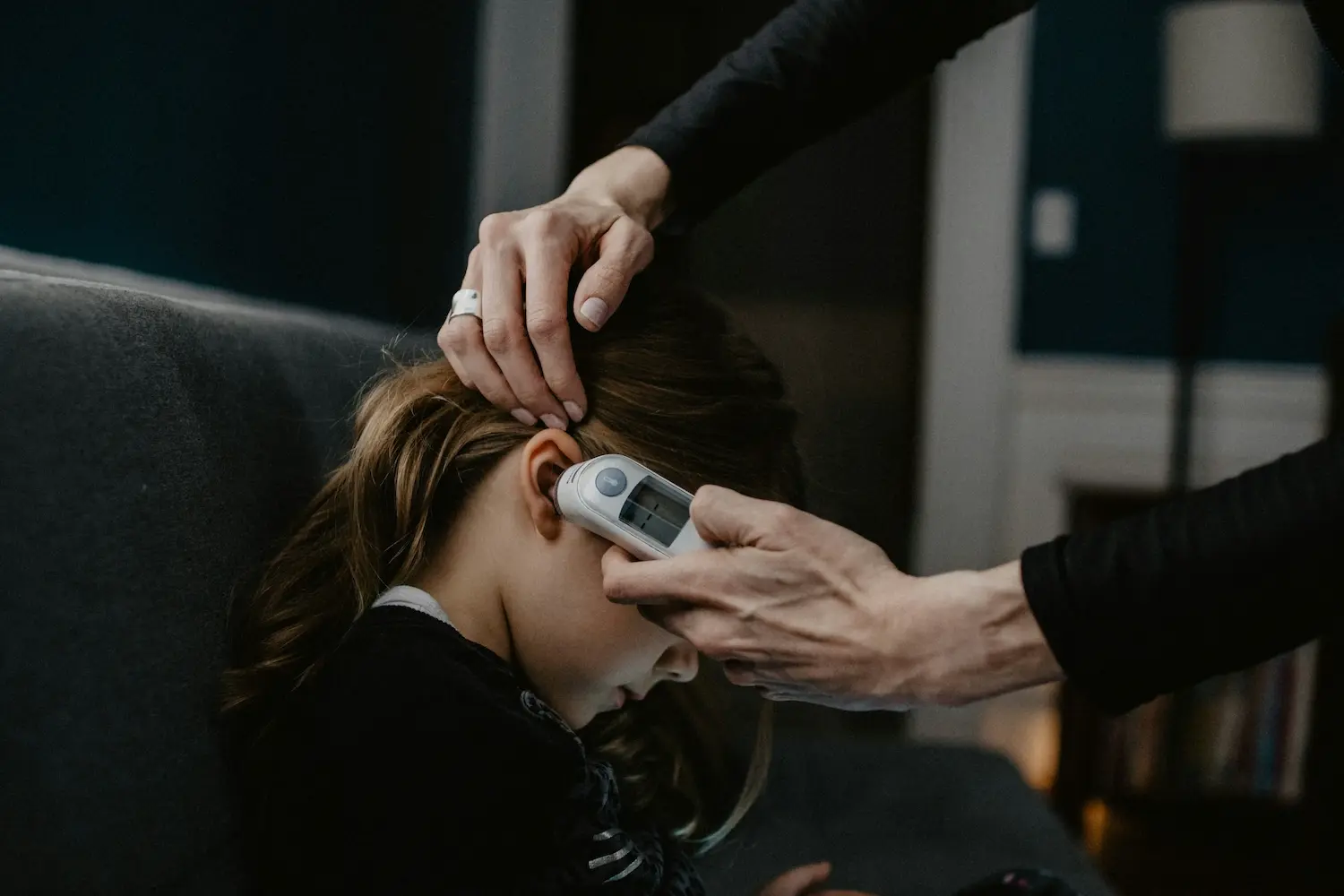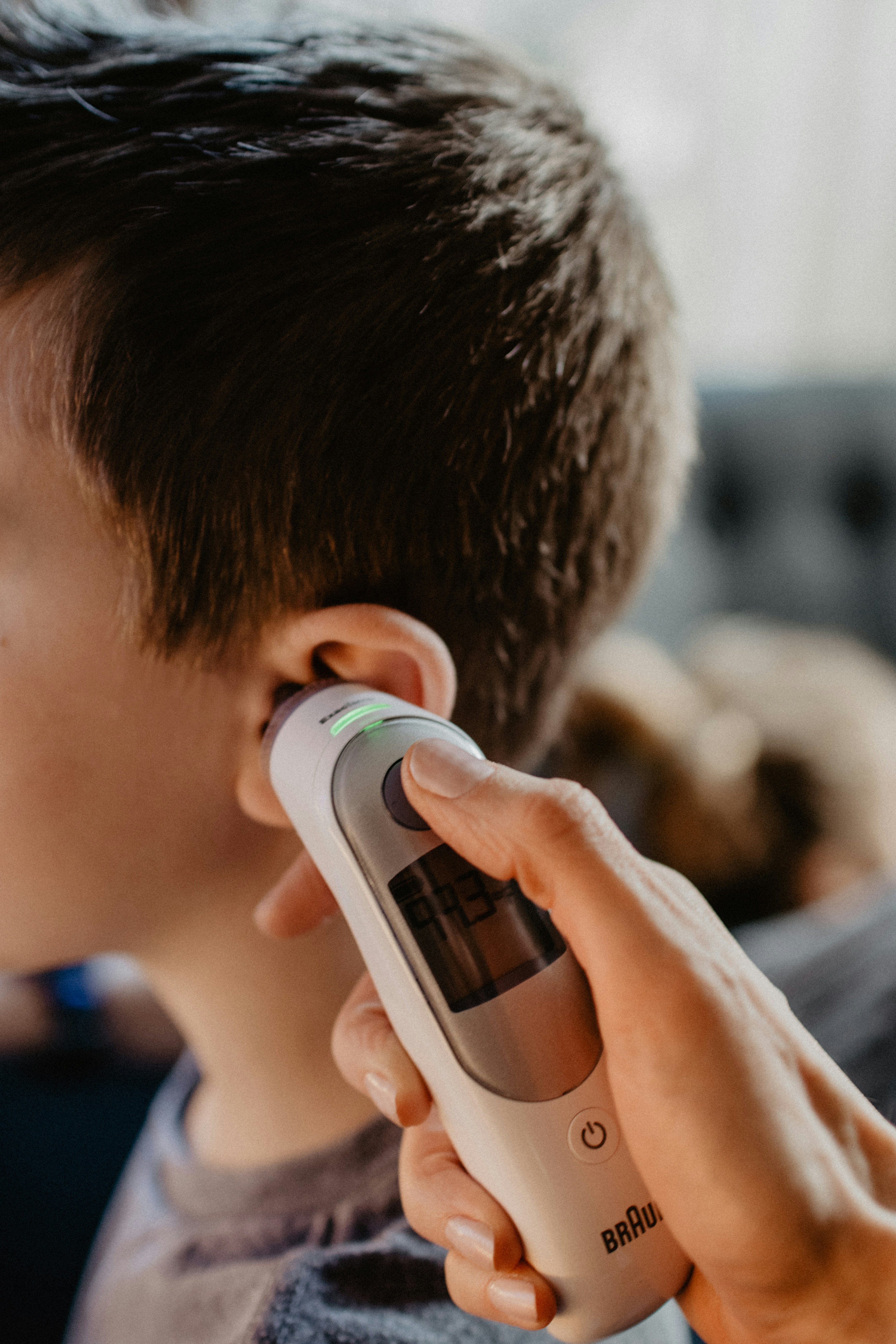Fever: How to take your child's temperature
Fever: How to take your child's temperature
Understanding fever, thermometer types, and how to measure body temperature and fever
Understanding fever, thermometer types, and how to measure body temperature and fever

Dahlia Rimmon, RDN
Content Writer

Dr. Marcy Borieux
Pediatrician



What is a fever?
A fever occurs when the body’s internal temperature rises as a response to an illness, signaling that the immune system is fighting off an infection. A fever in children is typically defined as a body temperature of 100.4°F (38°C) or higher. A normal temperature ranges from 96.4°F to 100.3°F (35°C to 37.9°C). If your child’s temperature reaches 100.4°F or above, contact your local or Summer Health pediatrician for support.
Newborns and young infants have developing immune systems, so they may not always exhibit a fever during illness. Instead, look for signs like fatigue, excessive irritability, or poor feeding.
Fever symptoms
Here are some other common symptoms of a fever:
Low energy and sleepiness
Irritability, crankiness, fussiness — all that fun stuff!
Rapid heart rate
Rapid/shallow breathing
Poor alertness
Shivering/chills
Poor feeding
Thermometer types
Digital thermometers measure temperature using electronic sensors and can be used in the mouth (oral thermometer), armpit, or rectum. The armpit reading is generally the most accurate. Digital thermometers should not be used to measure oral temperatures in children under 4 years old.
Digital ear thermometers use an infrared scanner to measure the temperature inside the ear canal. The presence of earwax or the shape and size of the ear can affect the accuracy of these readings.
Temporal artery thermometers measure temperature at the forehead using infrared technology.
Glass thermometers and mercury thermometers are no longer recommended and should not be used. Glass thermometers are sometimes called mercury thermometers because they contain mercury. They are not recommended because they easily break and can leak mercury, which is toxic.
How to measure body temperature and fever
Oral temperature: Place the tip of the thermometer under your child’s tongue, toward the back of their mouth. Their mouth should be closed until the thermometer beeps or signals the measurement is complete.
Armpit temperature: Position the thermometer tip under your child’s armpit, ensuring it touches their skin and isn’t obstructed by clothing. Keep their arm down over the thermometer to hold it in place in the armpit. Remove the thermometer when it beeps or signals that the temperature has been measured.
Rectal temperature: Lay your baby on their back and gently lift their legs towards their chest. Insert the thermometer tip into the anus and remove it once the rectal temperature has been measured. Always clean and sanitize the rectal thermometer after each use, and use it exclusively for rectal readings. Rectal thermometers are recommended because they provide a more accurate reading of your baby’s core temperature, or rectal temperature.
Petroleum jelly can be used to lubricate the thermometer tip to make it more comfortable. A rectal temperature reading is the most accurate temperature for babies, and is suitable for babies under 3 months. Always follow the manufacturer’s instructions.
Ear temperature : Insert the thermometer into your child’s ear canal and remove it once the measurement is complete. Ear thermometers are appropriate for children over 6 months since large ear canals are needed for accurate temperature measurements.
Temporal artery temperature (forehead temperature): This method can be used for children of all ages. It measures infrared heat waves from the blood vessel just below the skin on the forehead.
What type of thermometer is best?
The best type of thermometer depends on your child’s age. Rectal thermometers are recommended for young infants, and for older infants and toddlers, you can use forehead, ear, or armpit thermometers. For older kids, you can use an oral or forehead thermometer.
What causes a fever in children?
Upper respiratory infections
If your child has a cold or other viral infections like the flu, croup, or COVID-19, they may develop a fever. Along with a fever, your baby may have a cough, runny or stuffy nose, noisy breathing, fussiness, and trouble feeding.
Lower respiratory infections
Your child may catch viral bugs like RSV or bacterial infections which can lead to pneumonia in the lower respiratory tract. Along with a fever, your baby could have a severe cough, noisy breathing, rapid breathing, wheezing, poor feeding, and extreme sleepiness. These symptoms are serious and require immediate in-person care.
Middle ear infections
Middle ear infections happen when fluid or congestion builds up in the middle ear, often due to cold symptoms. Sometimes, fluid can collect in the ear if your baby is fed in a reclined or horizontal position.
Newborn infections
Newborn infections often show up when infants are just a few days or weeks old. If your baby is unusually fussy, very sleepy, not feeding well, less alert, or has a fever, they need immediate medical attention and should be taken to the emergency room.
Stomach bugs
Kids often catch stomach bugs, especially in the spring and summer. Since stomach bugs are usually viral, kids will get a fever and other symptoms like vomiting, diarrhea, fussiness, poor feeding, and fewer wet diapers. If your child is throwing up and having a lot of diarrhea, they could get dehydrated. Reach out to your child's pediatrician if you notice these symptoms or think they might be dehydrated.
What is a fever?
A fever occurs when the body’s internal temperature rises as a response to an illness, signaling that the immune system is fighting off an infection. A fever in children is typically defined as a body temperature of 100.4°F (38°C) or higher. A normal temperature ranges from 96.4°F to 100.3°F (35°C to 37.9°C). If your child’s temperature reaches 100.4°F or above, contact your local or Summer Health pediatrician for support.
Newborns and young infants have developing immune systems, so they may not always exhibit a fever during illness. Instead, look for signs like fatigue, excessive irritability, or poor feeding.
Fever symptoms
Here are some other common symptoms of a fever:
Low energy and sleepiness
Irritability, crankiness, fussiness — all that fun stuff!
Rapid heart rate
Rapid/shallow breathing
Poor alertness
Shivering/chills
Poor feeding
Thermometer types
Digital thermometers measure temperature using electronic sensors and can be used in the mouth (oral thermometer), armpit, or rectum. The armpit reading is generally the most accurate. Digital thermometers should not be used to measure oral temperatures in children under 4 years old.
Digital ear thermometers use an infrared scanner to measure the temperature inside the ear canal. The presence of earwax or the shape and size of the ear can affect the accuracy of these readings.
Temporal artery thermometers measure temperature at the forehead using infrared technology.
Glass thermometers and mercury thermometers are no longer recommended and should not be used. Glass thermometers are sometimes called mercury thermometers because they contain mercury. They are not recommended because they easily break and can leak mercury, which is toxic.
How to measure body temperature and fever
Oral temperature: Place the tip of the thermometer under your child’s tongue, toward the back of their mouth. Their mouth should be closed until the thermometer beeps or signals the measurement is complete.
Armpit temperature: Position the thermometer tip under your child’s armpit, ensuring it touches their skin and isn’t obstructed by clothing. Keep their arm down over the thermometer to hold it in place in the armpit. Remove the thermometer when it beeps or signals that the temperature has been measured.
Rectal temperature: Lay your baby on their back and gently lift their legs towards their chest. Insert the thermometer tip into the anus and remove it once the rectal temperature has been measured. Always clean and sanitize the rectal thermometer after each use, and use it exclusively for rectal readings. Rectal thermometers are recommended because they provide a more accurate reading of your baby’s core temperature, or rectal temperature.
Petroleum jelly can be used to lubricate the thermometer tip to make it more comfortable. A rectal temperature reading is the most accurate temperature for babies, and is suitable for babies under 3 months. Always follow the manufacturer’s instructions.
Ear temperature : Insert the thermometer into your child’s ear canal and remove it once the measurement is complete. Ear thermometers are appropriate for children over 6 months since large ear canals are needed for accurate temperature measurements.
Temporal artery temperature (forehead temperature): This method can be used for children of all ages. It measures infrared heat waves from the blood vessel just below the skin on the forehead.
What type of thermometer is best?
The best type of thermometer depends on your child’s age. Rectal thermometers are recommended for young infants, and for older infants and toddlers, you can use forehead, ear, or armpit thermometers. For older kids, you can use an oral or forehead thermometer.
What causes a fever in children?
Upper respiratory infections
If your child has a cold or other viral infections like the flu, croup, or COVID-19, they may develop a fever. Along with a fever, your baby may have a cough, runny or stuffy nose, noisy breathing, fussiness, and trouble feeding.
Lower respiratory infections
Your child may catch viral bugs like RSV or bacterial infections which can lead to pneumonia in the lower respiratory tract. Along with a fever, your baby could have a severe cough, noisy breathing, rapid breathing, wheezing, poor feeding, and extreme sleepiness. These symptoms are serious and require immediate in-person care.
Middle ear infections
Middle ear infections happen when fluid or congestion builds up in the middle ear, often due to cold symptoms. Sometimes, fluid can collect in the ear if your baby is fed in a reclined or horizontal position.
Newborn infections
Newborn infections often show up when infants are just a few days or weeks old. If your baby is unusually fussy, very sleepy, not feeding well, less alert, or has a fever, they need immediate medical attention and should be taken to the emergency room.
Stomach bugs
Kids often catch stomach bugs, especially in the spring and summer. Since stomach bugs are usually viral, kids will get a fever and other symptoms like vomiting, diarrhea, fussiness, poor feeding, and fewer wet diapers. If your child is throwing up and having a lot of diarrhea, they could get dehydrated. Reach out to your child's pediatrician if you notice these symptoms or think they might be dehydrated.
References
American Academy of Pediatrics: How to Take Your Child's Temperature
American Academy of Pediatrics: How to Take Your Child's Temperature
American Academy of Pediatrics: How to Take Your Child's Temperature
Summer Health offers fast and reliable pediatric urgent care through online doctors, all via text. Whether you’re worried about your baby's fever, rashes, or other children's health concerns, we provide expert advice and support anytime, right from your phone.

Never miss a post!
Sign up for our newsletter to receive articles and guides directly to your inbox!













